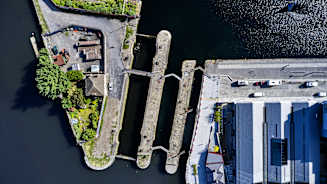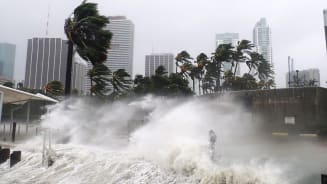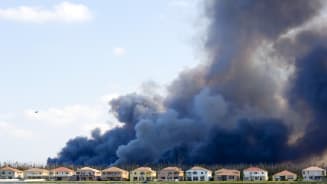Parametric: A Complement to Traditional Property Coverage

As property underwriters become increasingly concerned and cautious with catastrophe-prone risks, buyers are turning to alternative property solutions, including parametric, to fill protection gaps in their programs.
Key Takeaways
-
Natural catastrophes remain a major concern among primary insurers and reinsurers, creating a challenging market situation for buyers.
-
Parametric is a unique alternative risk solution that can complement traditional indemnity coverage.
-
Parametric provides a different approach to mitigating risk, especially when conventional products are restrictive.
Despite a moderating property market for well-performing risks, increasing natural catastrophe losses continue to paint a challenging picture in 2025 as underwriters become more cautious where climate-related exposures exist.
In 2024, Aon data found that insured natural catastrophe losses exceeded $100 billion for a fifth consecutive year, creating a growing challenge for insurers, reinsurers and businesses in volatile areas. Insured nat-cat losses in Q1 2025 of $53 billion were the second-highest quarterly total on record after Q1 2011, with California wildfires contributing approximately 71 percent ($37.5 billion) of that figure.
As a result, risk buyers are filling protection gaps in their risk management programs through increased retention and alternative risk solutions, like parametric. Parametric is an alternative solution that has grown in utilization to insure against a variety of perils, including non-damage business interruption, loss of attraction, loss of ingress/egress, and sub-limited or excluded coverage.
The Benefits Driving the Rise in Parametric
Parametric is a compelling and unique solution, especially in cat-prone areas where market capacity and terms are restricted, and rates are climbing. There are a few key factors driving this momentum:
- Independent: Coverage is triggered when predefined parameter thresholds measured and reported by a third party are met. This includes proximity and intensity of a storm, according to the National Oceanic and Atmospheric Administration. Through parametric, risk managers can clearly define events that will and will not pay claims, as well as the sum of those claims.
- Fast: Claim settlement is quicker and more transparent than traditional insurance solutions since the triggering event occurrence is binary. Coverage is usually confirmed within days and funds arrive within weeks — and without dispute.
- Flexible: Any covered economic loss ensuing from a triggering event is an indemnifiable expense under parametric insurance. This broad coverage helps address the protection gap in traditional policies. Uninsurable exposures become insurable with a parametric trigger. “Parametric products, under any market condition, enable clients to access coverage in different ways,” says Michael Gruetzmacher, head of Aon’s Alternative Risk Transfer in North America. “It creates an avenue for additional capacity for issues that are not covered by traditional property insurers and another source for clients to address volatility.”
Case Studies
-
Parametric: An Alternative Business Interruption Solution
Situation: A technology firm with a unique exposure was unable to obtain business interruption from the traditional property insurance market. Operations were highly concentrated and exposed to tornado risk.
Solution: The broker worked closely with the client to provide parametric tornado coverage, which would have been unobtainable for the client with traditional markets.
Outcome: The client achieved an alternative source of capacity and risk transfer that was not considered by the traditional market.
-
Eliminating the Protection Gap with Parametric
Situation: A coastal municipality was uncomfortable with its traditional property policy sub-limits, which had significantly limited recovery following a recent hurricane.
Solution: The broker designed a parametric hurricane policy to top-up the debris removal sub-limits, while also providing funds to address beach erosion issues that were not remedied by the U.S. Federal Emergency Management Agency.
Outcome: The client achieved a decreased risk burden on an already-thin budget. The parametric solution also decreased the taxpayer burden and provided a more efficient use of capital.
Parametric products, under any market condition, enable clients to access coverage in different ways.
Controlling Future Risks
Parametric provides a different way to think about mitigating risk, especially if conventional products are restricted, unavailable or not meeting an organization's needs. It serves as a strategic tool for companies to partner with insurers to help solve complex business challenges — and ultimately provide organizations with more transparency and better control.
“This is all about addressing the protection gap,” says Peter Lacovara, managing director in Aon’s Alternative Risk Transfer practice. “The market for nat-cat exposures is not just about price, but terms and conditions, too. And parametric, for all intents and purposes, does not have terms and conditions, deductibles, exclusions or sub-limits — and that’s where it shines. All those things that get tightened up when carriers get more sensitive to how they deploy capital make parametric more effective.”
General Disclaimer
This document is not intended to address any specific situation or to provide legal, regulatory, financial, or other advice. While care has been taken in the production of this document, Aon does not warrant, represent or guarantee the accuracy, adequacy, completeness or fitness for any purpose of the document or any part of it and can accept no liability for any loss incurred in any way by any person who may rely on it. Any recipient shall be responsible for the use to which it puts this document. This document has been compiled using information available to us up to its date of publication and is subject to any qualifications made in the document.
Terms of Use
The contents herein may not be reproduced, reused, reprinted or redistributed without the expressed written consent of Aon, unless otherwise authorized by Aon. To use information contained herein, please write to our team.
Aon's Better Being Podcast
Our Better Being podcast series, hosted by Aon Chief Wellbeing Officer Rachel Fellowes, explores wellbeing strategies and resilience. This season we cover human sustainability, kindness in the workplace, how to measure wellbeing, managing grief and more.
Aon Insights Series Asia
Expert Views on Today's Risk Capital and Human Capital Issues
Aon Insights Series Pacific
Expert Views on Today's Risk Capital and Human Capital Issues
Aon Insights Series UK
Expert Views on Today's Risk Capital and Human Capital Issues
Client Trends 2025
Better Decisions Across Interconnected Risk and People Issues.
Construction and Infrastructure
The construction industry is under pressure from interconnected risks and notable macroeconomic developments. Learn how your organization can benefit from construction insurance and risk management.
Cyber Labs
Stay in the loop on today's most pressing cyber security matters.
Cyber Resilience
Our Cyber Resilience collection gives you access to Aon’s latest insights on the evolving landscape of cyber threats and risk mitigation measures. Reach out to our experts to discuss how to make the right decisions to strengthen your organization’s cyber resilience.
Employee Wellbeing
Our Employee Wellbeing collection gives you access to the latest insights from Aon's human capital team. You can also reach out to the team at any time for assistance with your employee wellbeing needs.
Environmental, Social and Governance Insights
Explore Aon's latest environmental social and governance (ESG) insights.
Q4 2023 Global Insurance Market Insights
Our Global Insurance Market Insights highlight insurance market trends across pricing, capacity, underwriting, limits, deductibles and coverages.
Regional Results
How do the top risks on business leaders’ minds differ by region and how can these risks be mitigated? Explore the regional results to learn more.
Human Capital Analytics
Our Human Capital Analytics collection gives you access to the latest insights from Aon's human capital team. Contact us to learn how Aon’s analytics capabilities helps organizations make better workforce decisions.
Insights for HR
Explore our hand-picked insights for human resources professionals.
Workforce
Our Workforce Collection provides access to the latest insights from Aon’s Human Capital team on topics ranging from health and benefits, retirement and talent practices. You can reach out to our team at any time to learn how we can help address emerging workforce challenges.
Mergers and Acquisitions
Our Mergers and Acquisitions (M&A) collection gives you access to the latest insights from Aon's thought leaders to help dealmakers make better decisions. Explore our latest insights and reach out to the team at any time for assistance with transaction challenges and opportunities.
Navigating Volatility
How do businesses navigate their way through new forms of volatility and make decisions that protect and grow their organizations?
Parametric Insurance
Our Parametric Insurance Collection provides ways your organization can benefit from this simple, straightforward and fast-paying risk transfer solution. Reach out to learn how we can help you make better decisions to manage your catastrophe exposures and near-term volatility.
Pay Transparency and Equity
Our Pay Transparency and Equity collection gives you access to the latest insights from Aon's human capital team on topics ranging from pay equity to diversity, equity and inclusion. Contact us to learn how we can help your organization address these issues.
Property Risk Management
Forecasters are predicting an extremely active 2024 Atlantic hurricane season. Take measures to build resilience to mitigate risk for hurricane-prone properties.
Technology
Our Technology Collection provides access to the latest insights from Aon's thought leaders on navigating the evolving risks and opportunities of technology. Reach out to the team to learn how we can help you use technology to make better decisions for the future.
Top 10 Global Risks
Trade, technology, weather and workforce stability are the central forces in today’s risk landscape.
Trade
Our Trade Collection gives you access to the latest insights from Aon's thought leaders on navigating the evolving risks and opportunities for international business. Reach out to our team to understand how to make better decisions around macro trends and why they matter to businesses.
Weather
With a changing climate, organizations in all sectors will need to protect their people and physical assets, reduce their carbon footprint, and invest in new solutions to thrive. Our Weather Collection provides you with critical insights to be prepared.
Workforce Resilience
Our Workforce Resilience collection gives you access to the latest insights from Aon's Human Capital team. You can reach out to the team at any time for questions about how we can assess gaps and help build a more resilience workforce.
More Like This
-

Article 6 mins
3 Rules to Help Elevate Your Business Continuity Strategy
Half of the world’s top economic loss events impacted the U.S. in 2024. As natural catastrophes continue to grow in frequency and severity, enhancing a business continuity strategy helps ensure organizations are prepared for the unexpected.
-

Article 12 mins
A Targeted Strategy to Mitigate Rising U.S. Health Costs
While medical and pharmacy expenses continue to consume benefit budgets, employers can adopt effective cost-saving strategies that combine predictive analytics with innovative solutions to help control healthcare spend over a multi-year period.
-

Article 9 mins
Using Climate Data to Protect Employee Health
Employers are increasingly looking to defend the health and safety of their employees in a changing climate. By modeling the impact of weather on employees like they do for physical risks, employers can proactively establish solutions to protect workers.
























































































































































